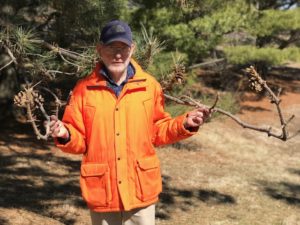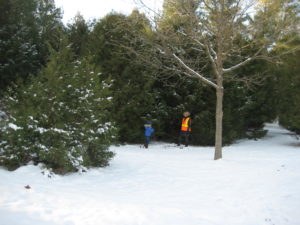Deer Repellent II
During the winter of 2017-18, I tested a deer repellent on young and vulnerable arbor vitae at our home in western Johnson County. It was successful, and I reported the details to you in A Winter Deer Repellent That Works dated last May. That was a lightweight test because it was a mild winter and the deer were not hard-pressed to obtain food. My control was a planting of spire-shaped arbor vitae cultivars in a wooded part of town, which the deer ate into their own version of topiary. Refer to that blog for details about the product and application.
This winter I applied the Plantskydd repellent to my same young arbor vitae by the same method as the previous year, but did so a month earlier, potentially giving it more time to wear or wash off, which is a flaw of many repellents.
Our winter of 2018-19 began mild and lightweight, and the deer had one of the most abundant acorn crops that I can remember to feed upon, so they went into December with a thick layer of fat. The one I shot in early December had two inches across the top of her hips. But in mid-January a real winter rolled in, with rather regular snowfalls and ice accumulating until early March, so non-hibernating wildlife became hard-pressed to find enough to eat. With their thick initial fat layer, the deer weren’t going to starve to death but they were hungry, as evidenced by the deer standing on their hind legs to browse pine needles.

Deer browse of Austrian pine.
Deer generally eat at their chest to head height first, then down low, then paw through the snow, and finally stand on their hind legs to reach up. And pine needles are usually ignored until there is little else left that they consider worth eating.

The older stand of arbor vitae.
With their food supplies running low by late February, I thought the deer would start cruising my young arbor vitae windbreak, hoping to find portions of individual bushy trees that I had neglected to spray with repellent. But their tracks showed that they went around the entire planting and did not walk through it. Either they were confident that I was thorough in my application or could smell it at a distance and were repelled, probably the latter. It probably also helped that there was an older unprotected stand of arbor vitae not far away.
My controls this year were the same arbor vitae cultivars on the edge of town, which the deer had thoroughly damaged the previous winter. And this winter they stood on their hind legs, which pushed their slender hooves deep through the thin ice crusts within the snowpack and left deep holes. But their reach still extended beyond that of the previous winter:

Late winter of 2017-18, Late winter 2018-19
Deer are not quite 100% vegetarians, and by early March, with the landscape becoming an icy crust, I thought that perhaps the temptation of my bright green and convenient arbor vitae might overcome their distaste for blood. So I did a quick and crude reapplication of the repellent – mixing two cups of powder in a bucket with warm water, and then sprinkling and dragging a couple of handfuls on each little tree with a thin rubber-gloved hand and then flicking the glove clean on each one. It only took a half hour or so for the entire procedure on 40 waist-high bushy trees. Subsequently, the tracks indicated the deer stayed away from the planting.
So it was not the perfect experiment, I could have only done half, but it was a quick and cheap insurance policy.
This product really works, and I again thank Mark Vitosh, our district forester, for putting me onto it. Mark is also an active member of Bur Oak Land Trust, and you should feel free to contact him with your tree questions.
My experience with the Plantskydd repellent is limited to deer feeding on arbor vitae in winter. The advertisement claims it will also repel rabbits, which I consider believable because they are also mostly vegetarian. Winter is the season for food shortages, while spring to fall is one of abundance, so the critters should be more readily repelled when they have other choices. And the arbor vitae is one of the best choices for deer in winter – being high enough in vitamin C to cure scurvy in people. So I anticipate that the product will solve most of your deer and rabbit problems when starting a young conservation planting, whether it be trees or a pollinator garden or wetland wildflowers or… But it will not inhibit deer bucks from racking saplings with their antlers during the rutting season.
Tags: deer repellent, Lon Drake, Plantskydd

